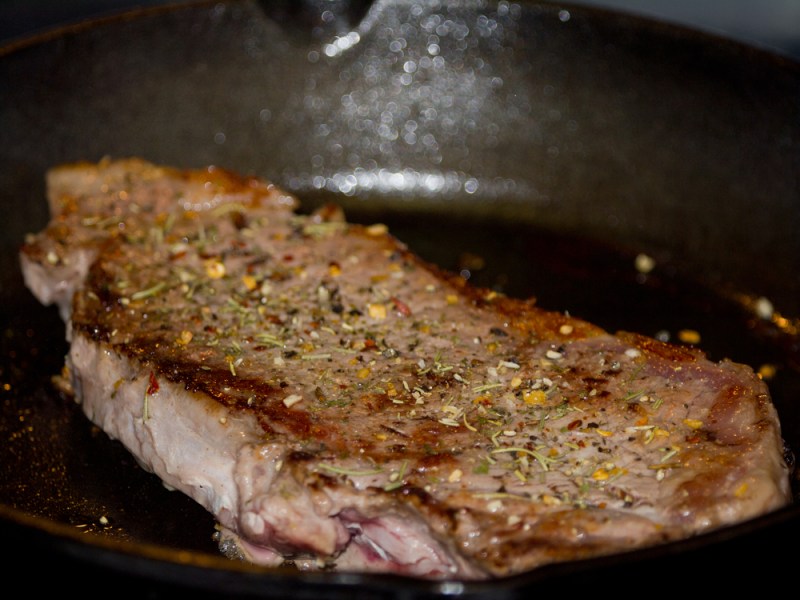Pan-searing is the simplest technique for cooking steak and is not only easy but fast as well. With a little patience and the right materials, you can add juicy, delicious seared steak to the list of staples in your home cooking repertoire.
Before You Start
Make sure you have an overhead fan to deal with the smoke. If the instructions are followed correctly, there will be smoke, and you’ll want that smoky air to circulate.
As far as equipment is concerned, you’ll want to use a 12-inch cast-iron skillet, or the bulkiest 12-inch stainless steel pan you can find. Cast-iron retains heat best, which will be helpful for browning the steak evenly.

Lisovskaya Natalia/Shutterstock
The Perfect Steak
Selecting a good quality steak is crucial if you want a tasty end result. Find the best quality meat you can afford, keeping an eye out for well-marbled steaks. The more fat distributed throughout the meat, the more tender and flavorful you’ll find your meal.
Keep in mind that pan-searing works best for either thin or thick steaks. Thinner steaks like a flank, hangar, or skirt steak are great for pan-searing and easier on the arteries. With a thick cut, like a ribeye, strip steak, or T-bone, aim for 1.5 to 2 inches of thickness for ideal juiciness.
Prep Materials
Before cooking, use paper towels to pull moisture off the steaks by patting the paper towels down to blot excess wetness. The dryer the steak, the more likely it will be to produce that glistening brown surface.
Season both sides of your steak with salt and pepper. (A good rule of thumb is 1/2 teaspoon of salt and 1/4 ground pepper per pound of meat.) Make sure to add salt immediately before cooking, since leaving salt on a steak for longer than a couple minutes will draw liquid out of the steak you’ll want to remain within.
For thin steaks, consider chopping and adding herbs like oregano, thyme, or rosemary before cooking, but for thicker steaks, hold off on adding herbs until later.

GCapture/Shutterstock
Start Searing
Heat the pan on high, adding 1-2 tablespoon(s) of vegetable oil, and stirring to coat the bottom of the pan. Continue heating the pan until the oil begins to smoke (which should not take long).
Slowly place your steak in the skillet, careful not to drop the steak in too suddenly and cause hot oil to spray out. If you’re searing more than one steak, leave a few inches of space between steaks.
Thinner steaks (less than 1.5 inches in thickness) should be cooked until the surface of the meat is browned. For medium rare, this should take about 3 minutes on either side. Depending on the preference of doneness, cooking may take longer.
Thicker steaks (1.5 inches thick or more) will take 8-12 minutes until the surface of the meat browns, and should be flipped halfway through cooking time. Insert an instant-read thermometer into the thickest part of the steak, checking for an internal temperature of 120°F for a medium-rare steak and 130°F for medium doneness.
Add Flavors
During the last 2 minutes of cooking a thicker steak, feel free to add butter, herbs, and/or garlic to the skillet for added flavor. The addition of 1-2 tablespoon(s) of butter can make for a rich, decadent flavor, but it has to be added near the end so the high heat doesn’t cause the butter to burn. Once the butter melts (which shouldn’t take long), tilt the pan to spread the butter around the steak and use a spoon to scoop the melted butter over top the steak so it sinks into the meat.

Rawpixel.com/Shutterstock
Let It Rest
After the steak is cooked to your liking and preferred doneness, turn off the stove and transfer the steak to a plate, immediately covering the plate with a loose tent of aluminum foil. For thin steaks, let the steak sit for 5 minutes, and let thick steaks rest for 10. The goal is to have the meat juice sink in and really permeate the steak, so try not to cheat, and leave your steak to breathe for best results!
Cut And Enjoy
Once your meat has sufficiently rested, slice against the grain of the meat and serve. The steak you’ve just seared should have a delicate but firm outer crust, and a juicy, flavorful interior. Enjoy!
